Investigating Training and Learning Problems of Lunchtime Supervisors
VerifiedAdded on 2023/06/08
|9
|2657
|467
Report
AI Summary
This report investigates the training and learning problems faced by school lunchtime supervisors. It highlights key features of effective training programs, including mentorship, coaching, patience, and problem-solving skills, emphasizing the application of cognitive learning theory. The report also identifies and justifies six creative HR techniques to enhance employee creativity in future training programs, such as case studies, coaching, instructor-led training, interactive training, and on-the-job training, all aimed at improving the supervisors' ability to manage children during lunchtime effectively. Desklib provides access to similar solved assignments and study materials for students.
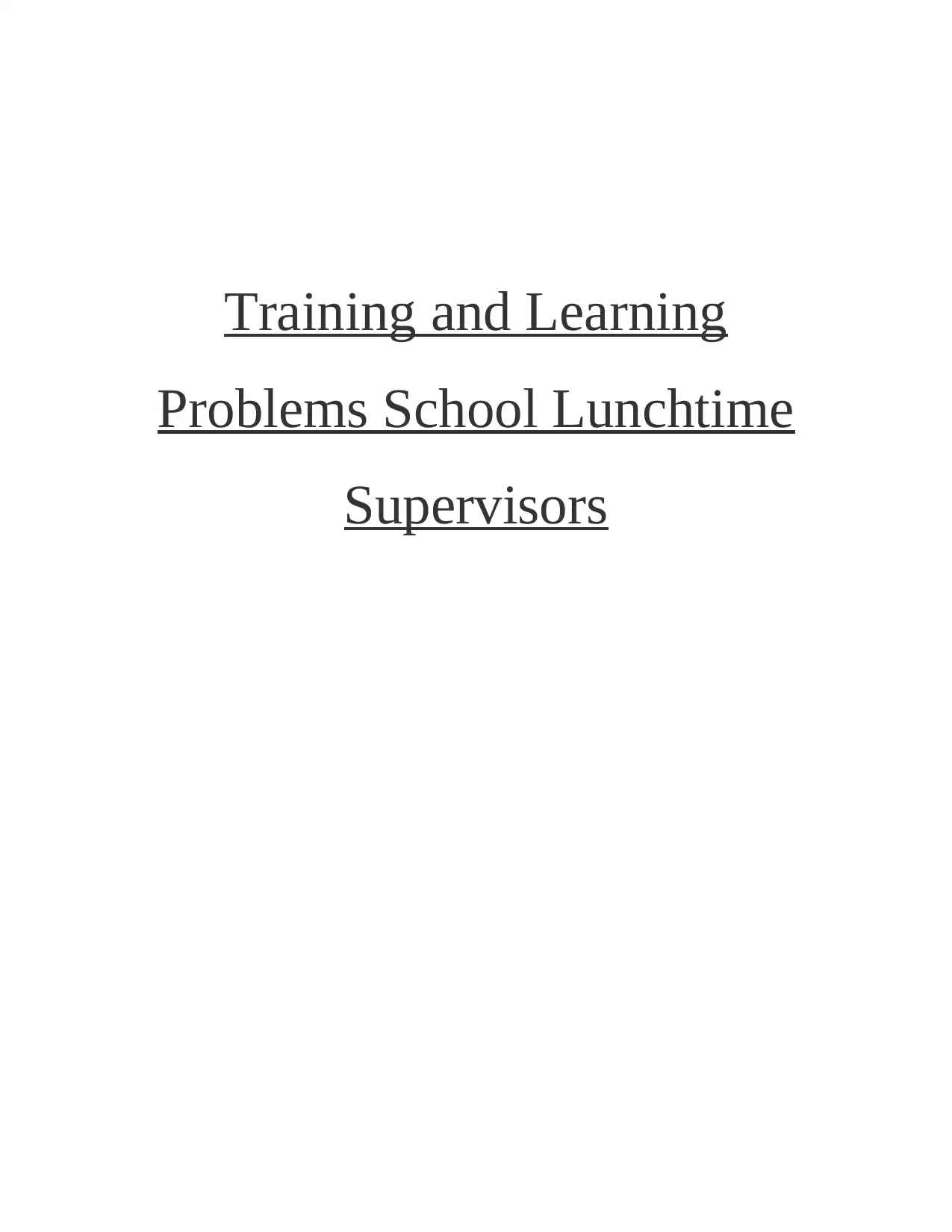
Training and Learning
Problems School Lunchtime
Supervisors
Problems School Lunchtime
Supervisors
Paraphrase This Document
Need a fresh take? Get an instant paraphrase of this document with our AI Paraphraser
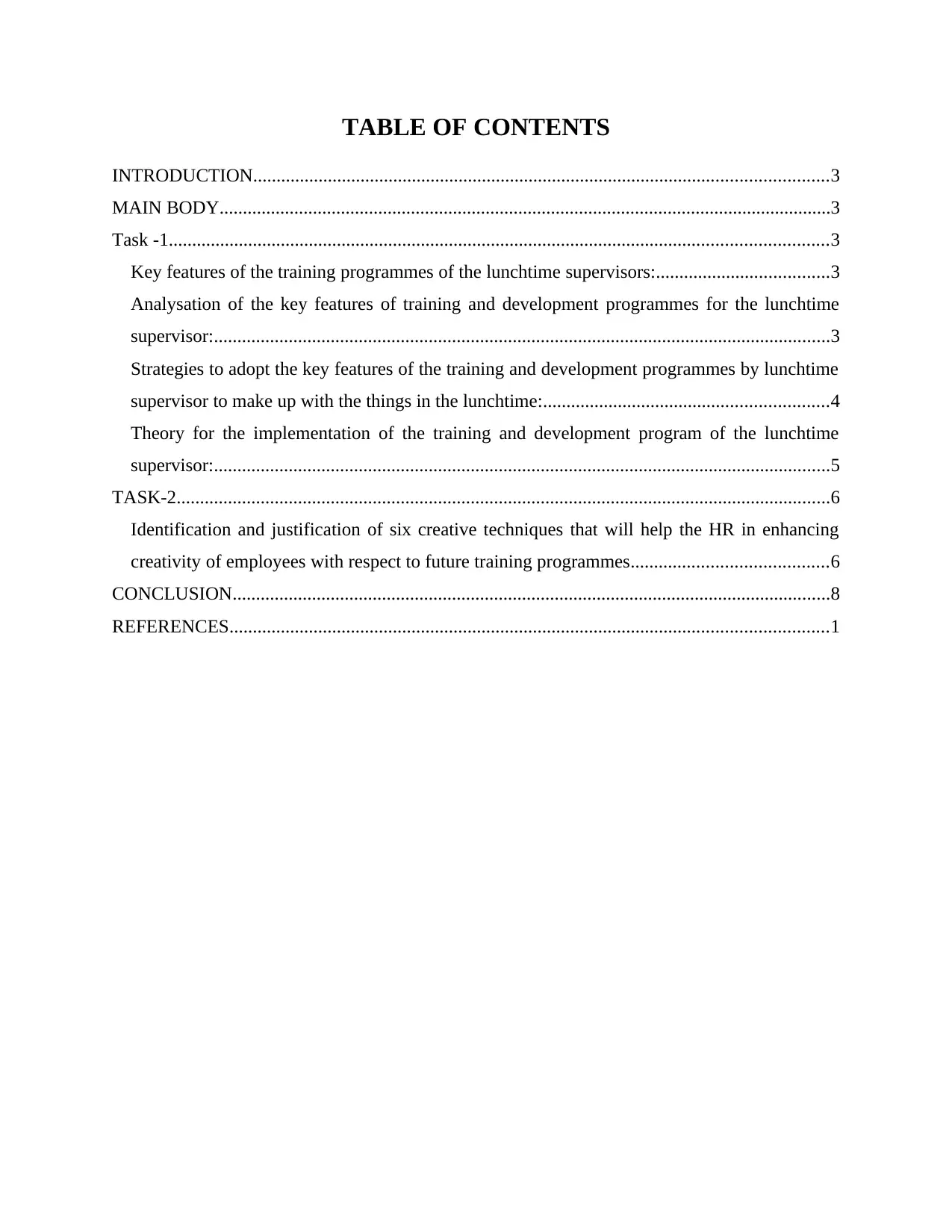
TABLE OF CONTENTS
INTRODUCTION...........................................................................................................................3
MAIN BODY...................................................................................................................................3
Task -1.............................................................................................................................................3
Key features of the training programmes of the lunchtime supervisors:.....................................3
Analysation of the key features of training and development programmes for the lunchtime
supervisor:....................................................................................................................................3
Strategies to adopt the key features of the training and development programmes by lunchtime
supervisor to make up with the things in the lunchtime:.............................................................4
Theory for the implementation of the training and development program of the lunchtime
supervisor:....................................................................................................................................5
TASK-2............................................................................................................................................6
Identification and justification of six creative techniques that will help the HR in enhancing
creativity of employees with respect to future training programmes..........................................6
CONCLUSION................................................................................................................................8
REFERENCES................................................................................................................................1
INTRODUCTION...........................................................................................................................3
MAIN BODY...................................................................................................................................3
Task -1.............................................................................................................................................3
Key features of the training programmes of the lunchtime supervisors:.....................................3
Analysation of the key features of training and development programmes for the lunchtime
supervisor:....................................................................................................................................3
Strategies to adopt the key features of the training and development programmes by lunchtime
supervisor to make up with the things in the lunchtime:.............................................................4
Theory for the implementation of the training and development program of the lunchtime
supervisor:....................................................................................................................................5
TASK-2............................................................................................................................................6
Identification and justification of six creative techniques that will help the HR in enhancing
creativity of employees with respect to future training programmes..........................................6
CONCLUSION................................................................................................................................8
REFERENCES................................................................................................................................1
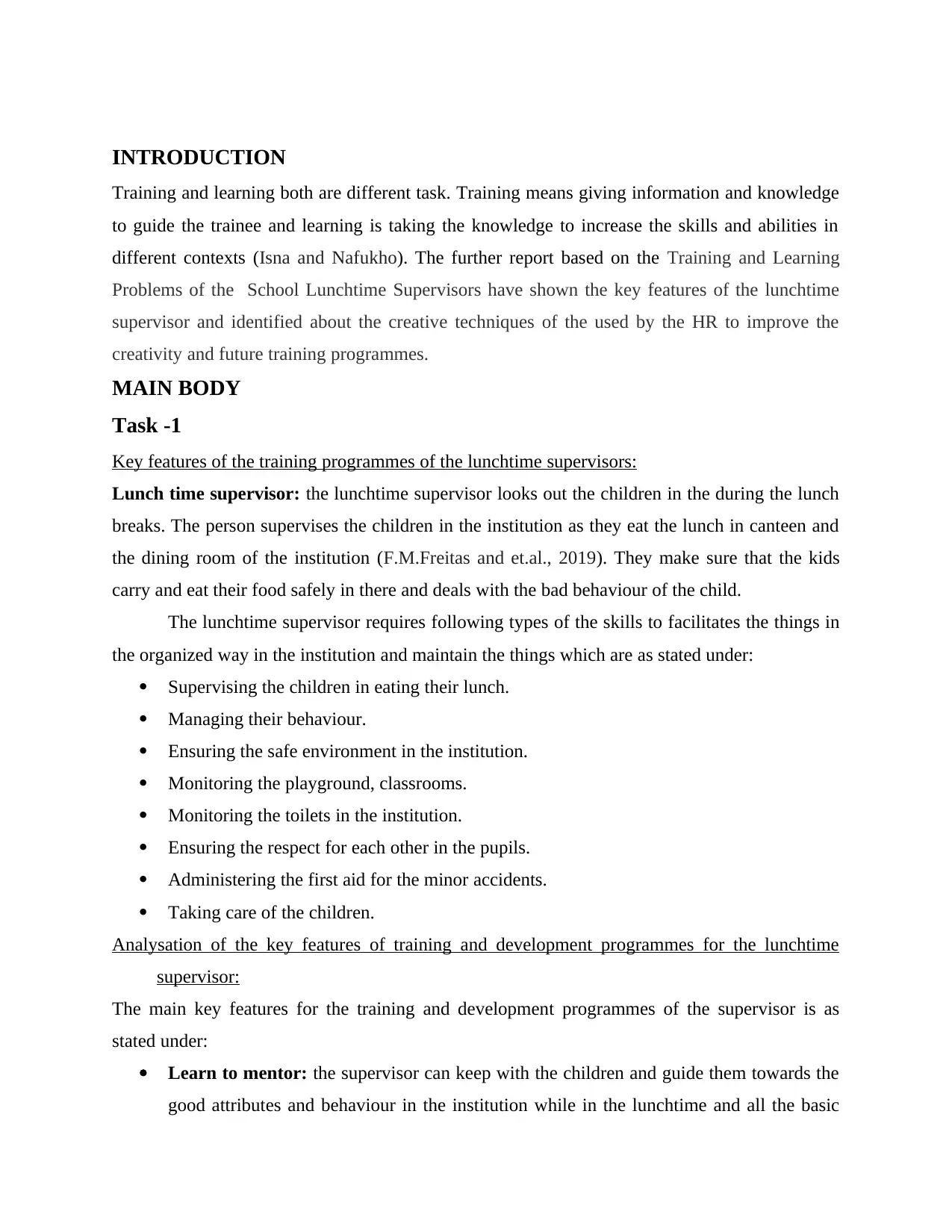
INTRODUCTION
Training and learning both are different task. Training means giving information and knowledge
to guide the trainee and learning is taking the knowledge to increase the skills and abilities in
different contexts (Isna and Nafukho). The further report based on the Training and Learning
Problems of the School Lunchtime Supervisors have shown the key features of the lunchtime
supervisor and identified about the creative techniques of the used by the HR to improve the
creativity and future training programmes.
MAIN BODY
Task -1
Key features of the training programmes of the lunchtime supervisors:
Lunch time supervisor: the lunchtime supervisor looks out the children in the during the lunch
breaks. The person supervises the children in the institution as they eat the lunch in canteen and
the dining room of the institution (F.M.Freitas and et.al., 2019). They make sure that the kids
carry and eat their food safely in there and deals with the bad behaviour of the child.
The lunchtime supervisor requires following types of the skills to facilitates the things in
the organized way in the institution and maintain the things which are as stated under:
Supervising the children in eating their lunch.
Managing their behaviour.
Ensuring the safe environment in the institution.
Monitoring the playground, classrooms.
Monitoring the toilets in the institution.
Ensuring the respect for each other in the pupils.
Administering the first aid for the minor accidents.
Taking care of the children.
Analysation of the key features of training and development programmes for the lunchtime
supervisor:
The main key features for the training and development programmes of the supervisor is as
stated under:
Learn to mentor: the supervisor can keep with the children and guide them towards the
good attributes and behaviour in the institution while in the lunchtime and all the basic
Training and learning both are different task. Training means giving information and knowledge
to guide the trainee and learning is taking the knowledge to increase the skills and abilities in
different contexts (Isna and Nafukho). The further report based on the Training and Learning
Problems of the School Lunchtime Supervisors have shown the key features of the lunchtime
supervisor and identified about the creative techniques of the used by the HR to improve the
creativity and future training programmes.
MAIN BODY
Task -1
Key features of the training programmes of the lunchtime supervisors:
Lunch time supervisor: the lunchtime supervisor looks out the children in the during the lunch
breaks. The person supervises the children in the institution as they eat the lunch in canteen and
the dining room of the institution (F.M.Freitas and et.al., 2019). They make sure that the kids
carry and eat their food safely in there and deals with the bad behaviour of the child.
The lunchtime supervisor requires following types of the skills to facilitates the things in
the organized way in the institution and maintain the things which are as stated under:
Supervising the children in eating their lunch.
Managing their behaviour.
Ensuring the safe environment in the institution.
Monitoring the playground, classrooms.
Monitoring the toilets in the institution.
Ensuring the respect for each other in the pupils.
Administering the first aid for the minor accidents.
Taking care of the children.
Analysation of the key features of training and development programmes for the lunchtime
supervisor:
The main key features for the training and development programmes of the supervisor is as
stated under:
Learn to mentor: the supervisor can keep with the children and guide them towards the
good attributes and behaviour in the institution while in the lunchtime and all the basic
⊘ This is a preview!⊘
Do you want full access?
Subscribe today to unlock all pages.

Trusted by 1+ million students worldwide
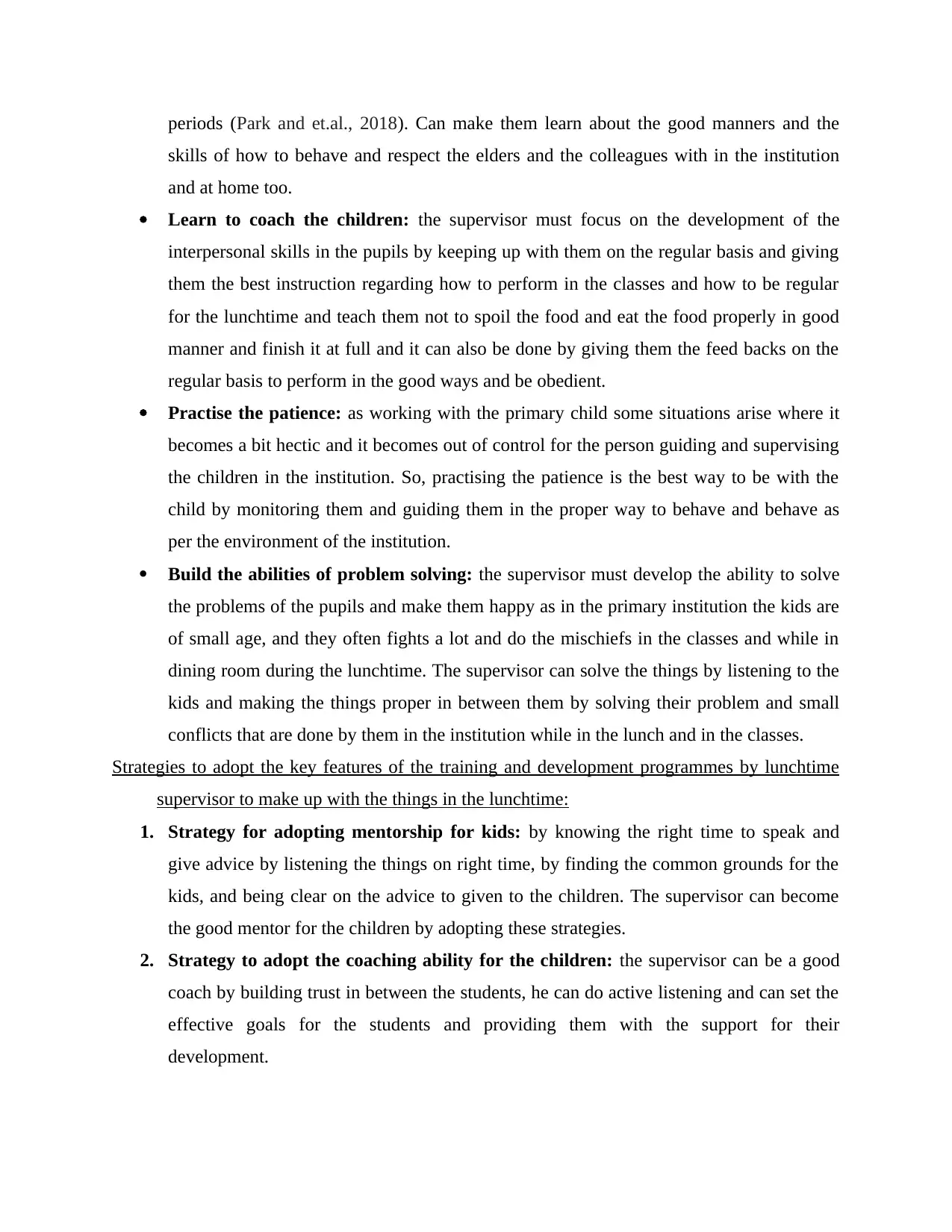
periods (Park and et.al., 2018). Can make them learn about the good manners and the
skills of how to behave and respect the elders and the colleagues with in the institution
and at home too.
Learn to coach the children: the supervisor must focus on the development of the
interpersonal skills in the pupils by keeping up with them on the regular basis and giving
them the best instruction regarding how to perform in the classes and how to be regular
for the lunchtime and teach them not to spoil the food and eat the food properly in good
manner and finish it at full and it can also be done by giving them the feed backs on the
regular basis to perform in the good ways and be obedient.
Practise the patience: as working with the primary child some situations arise where it
becomes a bit hectic and it becomes out of control for the person guiding and supervising
the children in the institution. So, practising the patience is the best way to be with the
child by monitoring them and guiding them in the proper way to behave and behave as
per the environment of the institution.
Build the abilities of problem solving: the supervisor must develop the ability to solve
the problems of the pupils and make them happy as in the primary institution the kids are
of small age, and they often fights a lot and do the mischiefs in the classes and while in
dining room during the lunchtime. The supervisor can solve the things by listening to the
kids and making the things proper in between them by solving their problem and small
conflicts that are done by them in the institution while in the lunch and in the classes.
Strategies to adopt the key features of the training and development programmes by lunchtime
supervisor to make up with the things in the lunchtime:
1. Strategy for adopting mentorship for kids: by knowing the right time to speak and
give advice by listening the things on right time, by finding the common grounds for the
kids, and being clear on the advice to given to the children. The supervisor can become
the good mentor for the children by adopting these strategies.
2. Strategy to adopt the coaching ability for the children: the supervisor can be a good
coach by building trust in between the students, he can do active listening and can set the
effective goals for the students and providing them with the support for their
development.
skills of how to behave and respect the elders and the colleagues with in the institution
and at home too.
Learn to coach the children: the supervisor must focus on the development of the
interpersonal skills in the pupils by keeping up with them on the regular basis and giving
them the best instruction regarding how to perform in the classes and how to be regular
for the lunchtime and teach them not to spoil the food and eat the food properly in good
manner and finish it at full and it can also be done by giving them the feed backs on the
regular basis to perform in the good ways and be obedient.
Practise the patience: as working with the primary child some situations arise where it
becomes a bit hectic and it becomes out of control for the person guiding and supervising
the children in the institution. So, practising the patience is the best way to be with the
child by monitoring them and guiding them in the proper way to behave and behave as
per the environment of the institution.
Build the abilities of problem solving: the supervisor must develop the ability to solve
the problems of the pupils and make them happy as in the primary institution the kids are
of small age, and they often fights a lot and do the mischiefs in the classes and while in
dining room during the lunchtime. The supervisor can solve the things by listening to the
kids and making the things proper in between them by solving their problem and small
conflicts that are done by them in the institution while in the lunch and in the classes.
Strategies to adopt the key features of the training and development programmes by lunchtime
supervisor to make up with the things in the lunchtime:
1. Strategy for adopting mentorship for kids: by knowing the right time to speak and
give advice by listening the things on right time, by finding the common grounds for the
kids, and being clear on the advice to given to the children. The supervisor can become
the good mentor for the children by adopting these strategies.
2. Strategy to adopt the coaching ability for the children: the supervisor can be a good
coach by building trust in between the students, he can do active listening and can set the
effective goals for the students and providing them with the support for their
development.
Paraphrase This Document
Need a fresh take? Get an instant paraphrase of this document with our AI Paraphraser
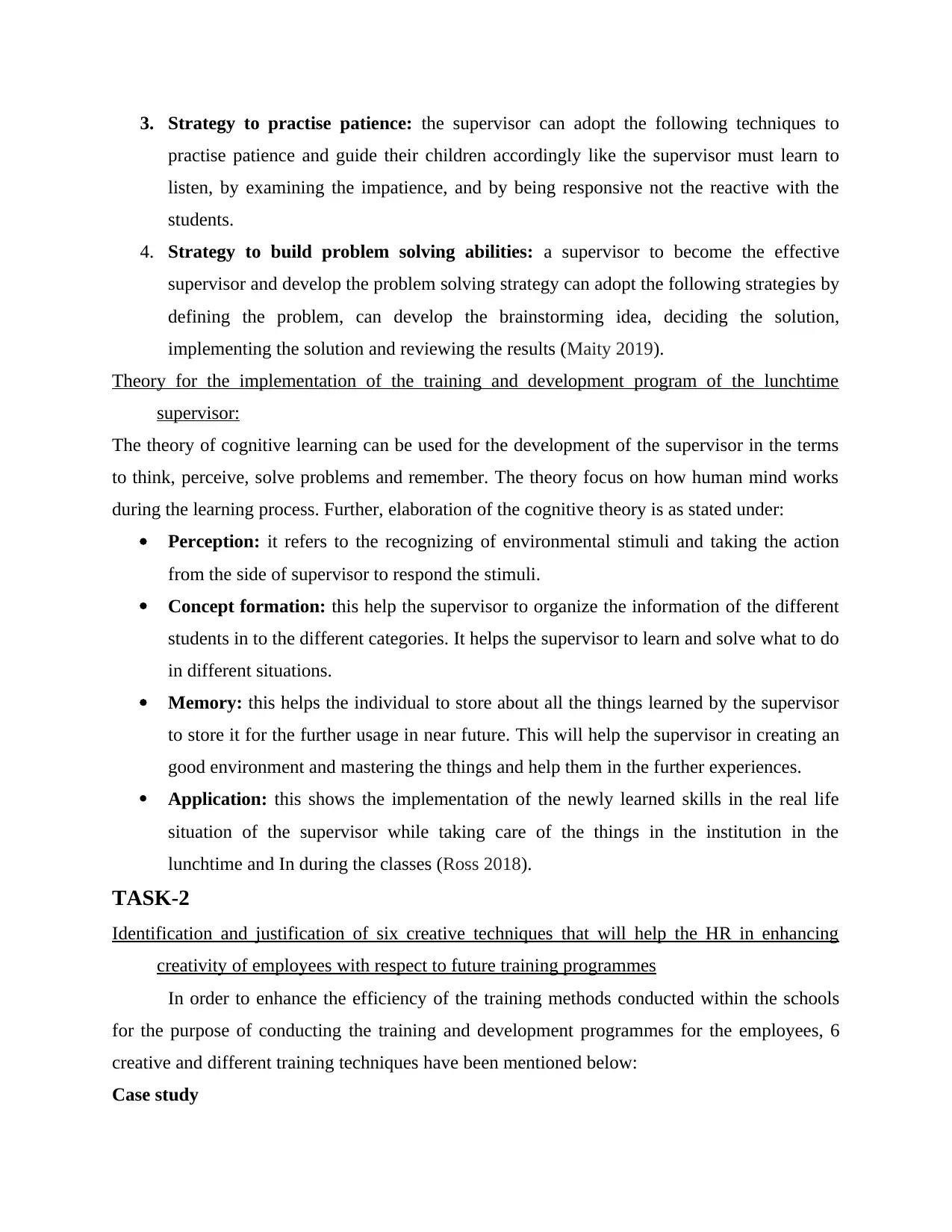
3. Strategy to practise patience: the supervisor can adopt the following techniques to
practise patience and guide their children accordingly like the supervisor must learn to
listen, by examining the impatience, and by being responsive not the reactive with the
students.
4. Strategy to build problem solving abilities: a supervisor to become the effective
supervisor and develop the problem solving strategy can adopt the following strategies by
defining the problem, can develop the brainstorming idea, deciding the solution,
implementing the solution and reviewing the results (Maity 2019).
Theory for the implementation of the training and development program of the lunchtime
supervisor:
The theory of cognitive learning can be used for the development of the supervisor in the terms
to think, perceive, solve problems and remember. The theory focus on how human mind works
during the learning process. Further, elaboration of the cognitive theory is as stated under:
Perception: it refers to the recognizing of environmental stimuli and taking the action
from the side of supervisor to respond the stimuli.
Concept formation: this help the supervisor to organize the information of the different
students in to the different categories. It helps the supervisor to learn and solve what to do
in different situations.
Memory: this helps the individual to store about all the things learned by the supervisor
to store it for the further usage in near future. This will help the supervisor in creating an
good environment and mastering the things and help them in the further experiences.
Application: this shows the implementation of the newly learned skills in the real life
situation of the supervisor while taking care of the things in the institution in the
lunchtime and In during the classes (Ross 2018).
TASK-2
Identification and justification of six creative techniques that will help the HR in enhancing
creativity of employees with respect to future training programmes
In order to enhance the efficiency of the training methods conducted within the schools
for the purpose of conducting the training and development programmes for the employees, 6
creative and different training techniques have been mentioned below:
Case study
practise patience and guide their children accordingly like the supervisor must learn to
listen, by examining the impatience, and by being responsive not the reactive with the
students.
4. Strategy to build problem solving abilities: a supervisor to become the effective
supervisor and develop the problem solving strategy can adopt the following strategies by
defining the problem, can develop the brainstorming idea, deciding the solution,
implementing the solution and reviewing the results (Maity 2019).
Theory for the implementation of the training and development program of the lunchtime
supervisor:
The theory of cognitive learning can be used for the development of the supervisor in the terms
to think, perceive, solve problems and remember. The theory focus on how human mind works
during the learning process. Further, elaboration of the cognitive theory is as stated under:
Perception: it refers to the recognizing of environmental stimuli and taking the action
from the side of supervisor to respond the stimuli.
Concept formation: this help the supervisor to organize the information of the different
students in to the different categories. It helps the supervisor to learn and solve what to do
in different situations.
Memory: this helps the individual to store about all the things learned by the supervisor
to store it for the further usage in near future. This will help the supervisor in creating an
good environment and mastering the things and help them in the further experiences.
Application: this shows the implementation of the newly learned skills in the real life
situation of the supervisor while taking care of the things in the institution in the
lunchtime and In during the classes (Ross 2018).
TASK-2
Identification and justification of six creative techniques that will help the HR in enhancing
creativity of employees with respect to future training programmes
In order to enhance the efficiency of the training methods conducted within the schools
for the purpose of conducting the training and development programmes for the employees, 6
creative and different training techniques have been mentioned below:
Case study
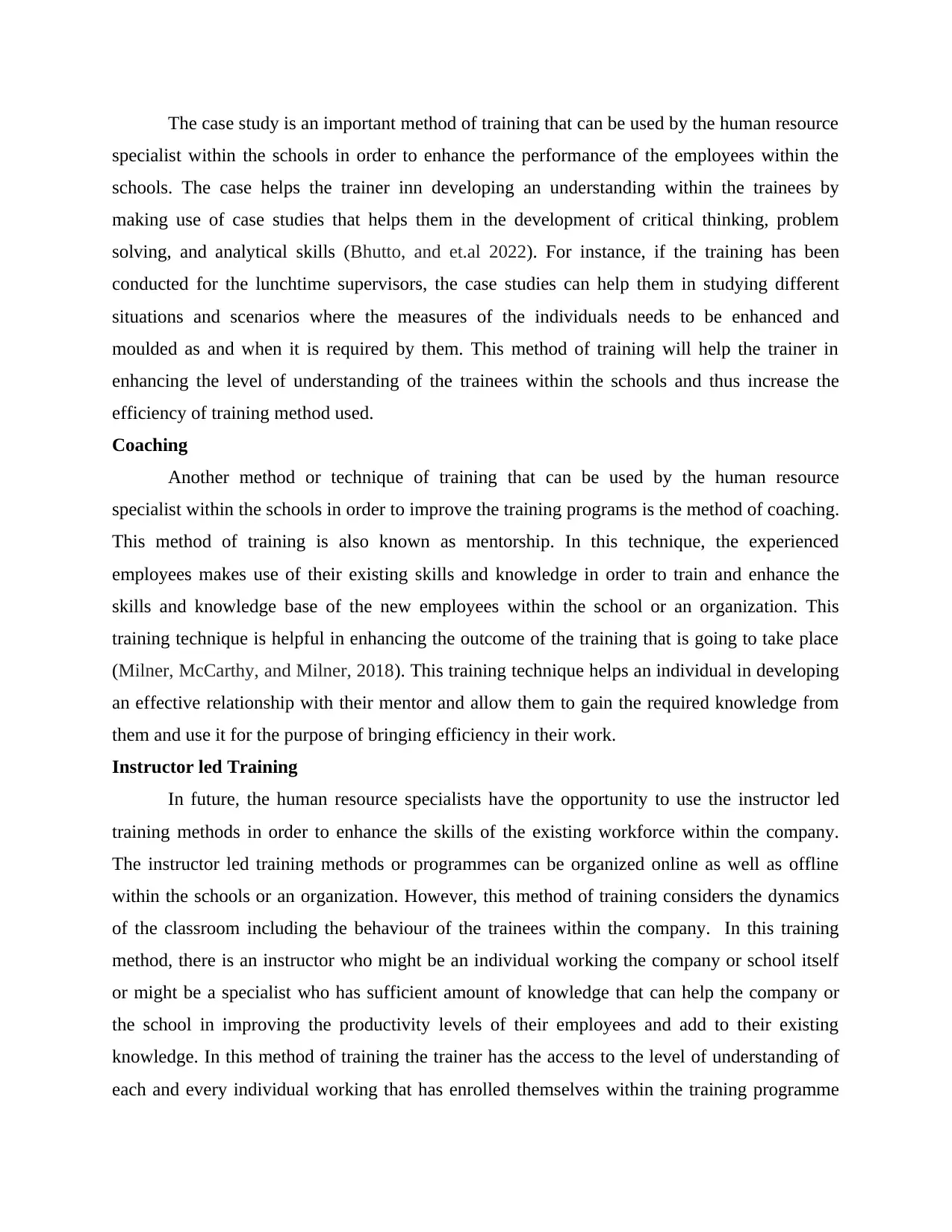
The case study is an important method of training that can be used by the human resource
specialist within the schools in order to enhance the performance of the employees within the
schools. The case helps the trainer inn developing an understanding within the trainees by
making use of case studies that helps them in the development of critical thinking, problem
solving, and analytical skills (Bhutto, and et.al 2022). For instance, if the training has been
conducted for the lunchtime supervisors, the case studies can help them in studying different
situations and scenarios where the measures of the individuals needs to be enhanced and
moulded as and when it is required by them. This method of training will help the trainer in
enhancing the level of understanding of the trainees within the schools and thus increase the
efficiency of training method used.
Coaching
Another method or technique of training that can be used by the human resource
specialist within the schools in order to improve the training programs is the method of coaching.
This method of training is also known as mentorship. In this technique, the experienced
employees makes use of their existing skills and knowledge in order to train and enhance the
skills and knowledge base of the new employees within the school or an organization. This
training technique is helpful in enhancing the outcome of the training that is going to take place
(Milner, McCarthy, and Milner, 2018). This training technique helps an individual in developing
an effective relationship with their mentor and allow them to gain the required knowledge from
them and use it for the purpose of bringing efficiency in their work.
Instructor led Training
In future, the human resource specialists have the opportunity to use the instructor led
training methods in order to enhance the skills of the existing workforce within the company.
The instructor led training methods or programmes can be organized online as well as offline
within the schools or an organization. However, this method of training considers the dynamics
of the classroom including the behaviour of the trainees within the company. In this training
method, there is an instructor who might be an individual working the company or school itself
or might be a specialist who has sufficient amount of knowledge that can help the company or
the school in improving the productivity levels of their employees and add to their existing
knowledge. In this method of training the trainer has the access to the level of understanding of
each and every individual working that has enrolled themselves within the training programme
specialist within the schools in order to enhance the performance of the employees within the
schools. The case helps the trainer inn developing an understanding within the trainees by
making use of case studies that helps them in the development of critical thinking, problem
solving, and analytical skills (Bhutto, and et.al 2022). For instance, if the training has been
conducted for the lunchtime supervisors, the case studies can help them in studying different
situations and scenarios where the measures of the individuals needs to be enhanced and
moulded as and when it is required by them. This method of training will help the trainer in
enhancing the level of understanding of the trainees within the schools and thus increase the
efficiency of training method used.
Coaching
Another method or technique of training that can be used by the human resource
specialist within the schools in order to improve the training programs is the method of coaching.
This method of training is also known as mentorship. In this technique, the experienced
employees makes use of their existing skills and knowledge in order to train and enhance the
skills and knowledge base of the new employees within the school or an organization. This
training technique is helpful in enhancing the outcome of the training that is going to take place
(Milner, McCarthy, and Milner, 2018). This training technique helps an individual in developing
an effective relationship with their mentor and allow them to gain the required knowledge from
them and use it for the purpose of bringing efficiency in their work.
Instructor led Training
In future, the human resource specialists have the opportunity to use the instructor led
training methods in order to enhance the skills of the existing workforce within the company.
The instructor led training methods or programmes can be organized online as well as offline
within the schools or an organization. However, this method of training considers the dynamics
of the classroom including the behaviour of the trainees within the company. In this training
method, there is an instructor who might be an individual working the company or school itself
or might be a specialist who has sufficient amount of knowledge that can help the company or
the school in improving the productivity levels of their employees and add to their existing
knowledge. In this method of training the trainer has the access to the level of understanding of
each and every individual working that has enrolled themselves within the training programme
⊘ This is a preview!⊘
Do you want full access?
Subscribe today to unlock all pages.

Trusted by 1+ million students worldwide
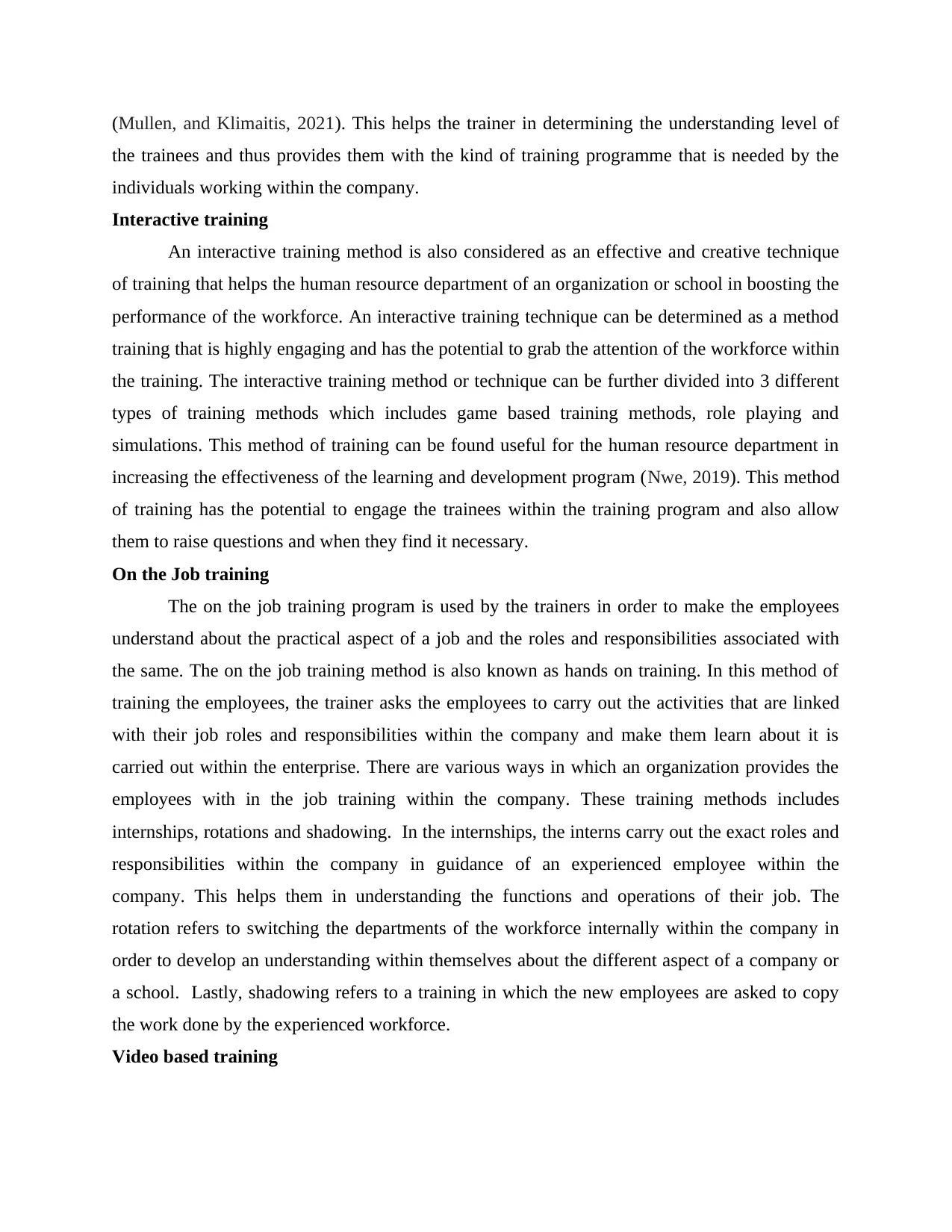
(Mullen, and Klimaitis, 2021). This helps the trainer in determining the understanding level of
the trainees and thus provides them with the kind of training programme that is needed by the
individuals working within the company.
Interactive training
An interactive training method is also considered as an effective and creative technique
of training that helps the human resource department of an organization or school in boosting the
performance of the workforce. An interactive training technique can be determined as a method
training that is highly engaging and has the potential to grab the attention of the workforce within
the training. The interactive training method or technique can be further divided into 3 different
types of training methods which includes game based training methods, role playing and
simulations. This method of training can be found useful for the human resource department in
increasing the effectiveness of the learning and development program (Nwe, 2019). This method
of training has the potential to engage the trainees within the training program and also allow
them to raise questions and when they find it necessary.
On the Job training
The on the job training program is used by the trainers in order to make the employees
understand about the practical aspect of a job and the roles and responsibilities associated with
the same. The on the job training method is also known as hands on training. In this method of
training the employees, the trainer asks the employees to carry out the activities that are linked
with their job roles and responsibilities within the company and make them learn about it is
carried out within the enterprise. There are various ways in which an organization provides the
employees with in the job training within the company. These training methods includes
internships, rotations and shadowing. In the internships, the interns carry out the exact roles and
responsibilities within the company in guidance of an experienced employee within the
company. This helps them in understanding the functions and operations of their job. The
rotation refers to switching the departments of the workforce internally within the company in
order to develop an understanding within themselves about the different aspect of a company or
a school. Lastly, shadowing refers to a training in which the new employees are asked to copy
the work done by the experienced workforce.
Video based training
the trainees and thus provides them with the kind of training programme that is needed by the
individuals working within the company.
Interactive training
An interactive training method is also considered as an effective and creative technique
of training that helps the human resource department of an organization or school in boosting the
performance of the workforce. An interactive training technique can be determined as a method
training that is highly engaging and has the potential to grab the attention of the workforce within
the training. The interactive training method or technique can be further divided into 3 different
types of training methods which includes game based training methods, role playing and
simulations. This method of training can be found useful for the human resource department in
increasing the effectiveness of the learning and development program (Nwe, 2019). This method
of training has the potential to engage the trainees within the training program and also allow
them to raise questions and when they find it necessary.
On the Job training
The on the job training program is used by the trainers in order to make the employees
understand about the practical aspect of a job and the roles and responsibilities associated with
the same. The on the job training method is also known as hands on training. In this method of
training the employees, the trainer asks the employees to carry out the activities that are linked
with their job roles and responsibilities within the company and make them learn about it is
carried out within the enterprise. There are various ways in which an organization provides the
employees with in the job training within the company. These training methods includes
internships, rotations and shadowing. In the internships, the interns carry out the exact roles and
responsibilities within the company in guidance of an experienced employee within the
company. This helps them in understanding the functions and operations of their job. The
rotation refers to switching the departments of the workforce internally within the company in
order to develop an understanding within themselves about the different aspect of a company or
a school. Lastly, shadowing refers to a training in which the new employees are asked to copy
the work done by the experienced workforce.
Video based training
Paraphrase This Document
Need a fresh take? Get an instant paraphrase of this document with our AI Paraphraser
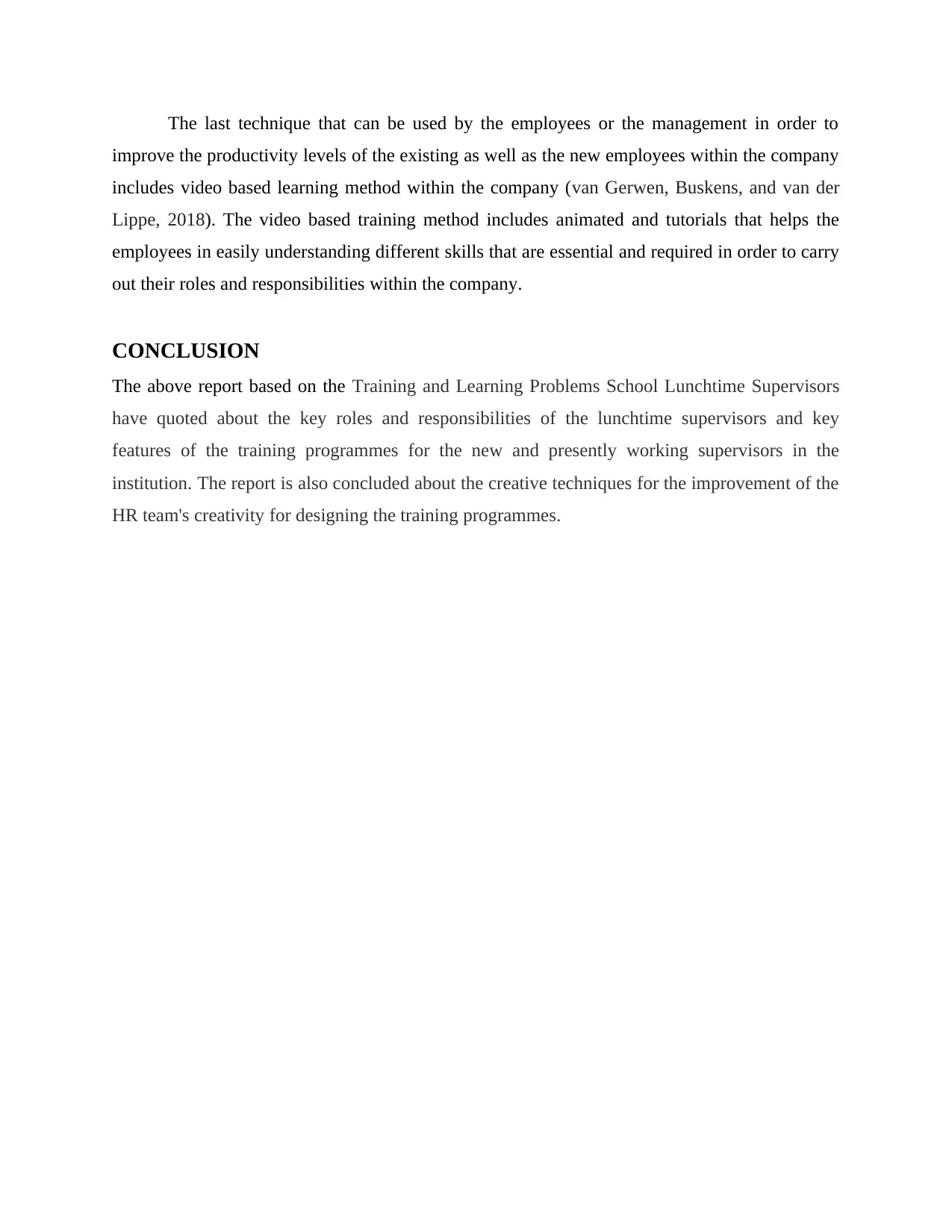
The last technique that can be used by the employees or the management in order to
improve the productivity levels of the existing as well as the new employees within the company
includes video based learning method within the company (van Gerwen, Buskens, and van der
Lippe, 2018). The video based training method includes animated and tutorials that helps the
employees in easily understanding different skills that are essential and required in order to carry
out their roles and responsibilities within the company.
CONCLUSION
The above report based on the Training and Learning Problems School Lunchtime Supervisors
have quoted about the key roles and responsibilities of the lunchtime supervisors and key
features of the training programmes for the new and presently working supervisors in the
institution. The report is also concluded about the creative techniques for the improvement of the
HR team's creativity for designing the training programmes.
improve the productivity levels of the existing as well as the new employees within the company
includes video based learning method within the company (van Gerwen, Buskens, and van der
Lippe, 2018). The video based training method includes animated and tutorials that helps the
employees in easily understanding different skills that are essential and required in order to carry
out their roles and responsibilities within the company.
CONCLUSION
The above report based on the Training and Learning Problems School Lunchtime Supervisors
have quoted about the key roles and responsibilities of the lunchtime supervisors and key
features of the training programmes for the new and presently working supervisors in the
institution. The report is also concluded about the creative techniques for the improvement of the
HR team's creativity for designing the training programmes.
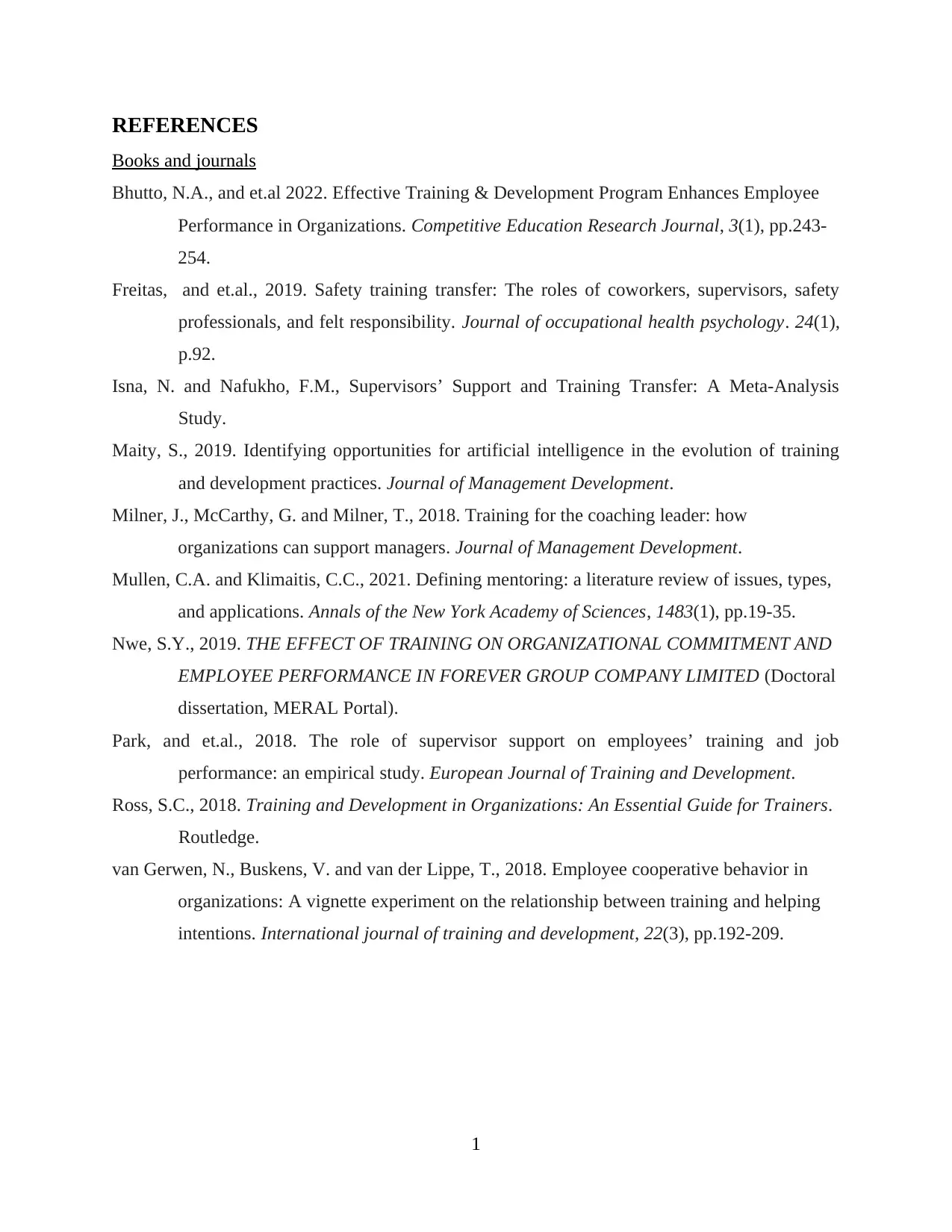
REFERENCES
Books and journals
Bhutto, N.A., and et.al 2022. Effective Training & Development Program Enhances Employee
Performance in Organizations. Competitive Education Research Journal, 3(1), pp.243-
254.
Freitas, and et.al., 2019. Safety training transfer: The roles of coworkers, supervisors, safety
professionals, and felt responsibility. Journal of occupational health psychology. 24(1),
p.92.
Isna, N. and Nafukho, F.M., Supervisors’ Support and Training Transfer: A Meta-Analysis
Study.
Maity, S., 2019. Identifying opportunities for artificial intelligence in the evolution of training
and development practices. Journal of Management Development.
Milner, J., McCarthy, G. and Milner, T., 2018. Training for the coaching leader: how
organizations can support managers. Journal of Management Development.
Mullen, C.A. and Klimaitis, C.C., 2021. Defining mentoring: a literature review of issues, types,
and applications. Annals of the New York Academy of Sciences, 1483(1), pp.19-35.
Nwe, S.Y., 2019. THE EFFECT OF TRAINING ON ORGANIZATIONAL COMMITMENT AND
EMPLOYEE PERFORMANCE IN FOREVER GROUP COMPANY LIMITED (Doctoral
dissertation, MERAL Portal).
Park, and et.al., 2018. The role of supervisor support on employees’ training and job
performance: an empirical study. European Journal of Training and Development.
Ross, S.C., 2018. Training and Development in Organizations: An Essential Guide for Trainers.
Routledge.
van Gerwen, N., Buskens, V. and van der Lippe, T., 2018. Employee cooperative behavior in
organizations: A vignette experiment on the relationship between training and helping
intentions. International journal of training and development, 22(3), pp.192-209.
1
Books and journals
Bhutto, N.A., and et.al 2022. Effective Training & Development Program Enhances Employee
Performance in Organizations. Competitive Education Research Journal, 3(1), pp.243-
254.
Freitas, and et.al., 2019. Safety training transfer: The roles of coworkers, supervisors, safety
professionals, and felt responsibility. Journal of occupational health psychology. 24(1),
p.92.
Isna, N. and Nafukho, F.M., Supervisors’ Support and Training Transfer: A Meta-Analysis
Study.
Maity, S., 2019. Identifying opportunities for artificial intelligence in the evolution of training
and development practices. Journal of Management Development.
Milner, J., McCarthy, G. and Milner, T., 2018. Training for the coaching leader: how
organizations can support managers. Journal of Management Development.
Mullen, C.A. and Klimaitis, C.C., 2021. Defining mentoring: a literature review of issues, types,
and applications. Annals of the New York Academy of Sciences, 1483(1), pp.19-35.
Nwe, S.Y., 2019. THE EFFECT OF TRAINING ON ORGANIZATIONAL COMMITMENT AND
EMPLOYEE PERFORMANCE IN FOREVER GROUP COMPANY LIMITED (Doctoral
dissertation, MERAL Portal).
Park, and et.al., 2018. The role of supervisor support on employees’ training and job
performance: an empirical study. European Journal of Training and Development.
Ross, S.C., 2018. Training and Development in Organizations: An Essential Guide for Trainers.
Routledge.
van Gerwen, N., Buskens, V. and van der Lippe, T., 2018. Employee cooperative behavior in
organizations: A vignette experiment on the relationship between training and helping
intentions. International journal of training and development, 22(3), pp.192-209.
1
⊘ This is a preview!⊘
Do you want full access?
Subscribe today to unlock all pages.

Trusted by 1+ million students worldwide
1 out of 9
Related Documents
Your All-in-One AI-Powered Toolkit for Academic Success.
+13062052269
info@desklib.com
Available 24*7 on WhatsApp / Email
![[object Object]](/_next/static/media/star-bottom.7253800d.svg)
Unlock your academic potential
Copyright © 2020–2025 A2Z Services. All Rights Reserved. Developed and managed by ZUCOL.




